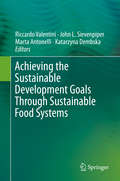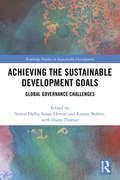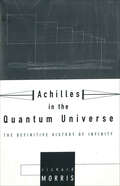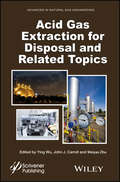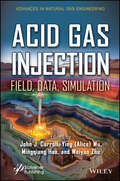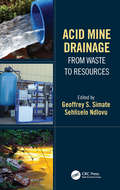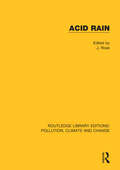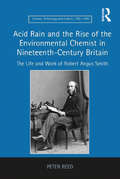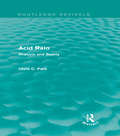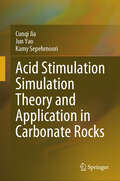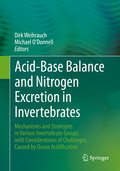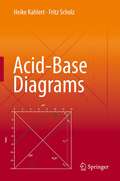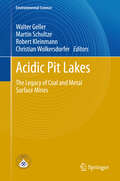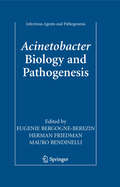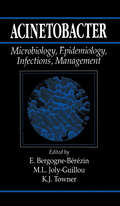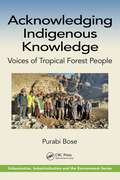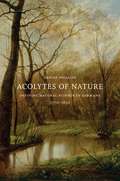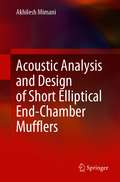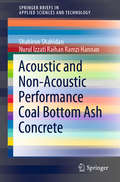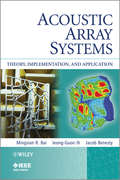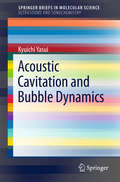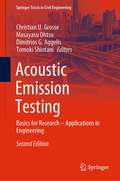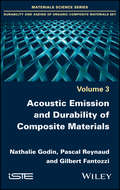- Table View
- List View
Achieving the Sustainable Development Goal Against Poverty in Developing Nations: Perspective from Urban Land Titling Potentials (Sustainable Development Goals Series)
by Solomon Pelumi Akinbogun Victor Olutope Ige Colin Anthony JonesThis book investigates the role of land titling in delivering sustainable means of poverty alleviation in developing countries. Despite the huge amount spent on various anti-poverty programs annually, poverty remains a major problem. This persistent challenge necessitates a paradigm shift in which urban poverty could be alleviated in developing countries by leveraging the potential of land titling. Titling could provide the urban poor with the opportunity to use their property titles as collateral for loans, allowing individuals to invest in businesses, upgrade their homes, and lift themselves out of poverty. As a result, job creation and income generation may increase. Land titling is a simple, inexpensive, and effective means of supporting the urban poor, particularly those with small- and medium-sized enterprise (SME) initiatives. Similarly, land titling is an antidote to the limited success of property taxation in developing countries, as it provides mapped and transaction-based records. This book will help stakeholders, policymakers, and policy implementers understand and utilize the capacity of titling as a veritable means of poverty alleviation and SME development in developing nations.
Achieving the Sustainable Development Goals Through Sustainable Food Systems (Food And Health Ser.)
by Marta Antonelli Riccardo Valentini John L. Sievenpiper Katarzyna DembskaThis publication offers a systemic analysis of sustainability in the food system, taking as its framework the Sustainable Development Goals of the 2030 Agenda of the United Nations. Targeted chapters from experts in the field cover main challenges in the food system and propose methods for achieving long term sustainability. Authors focus on how sustainability can be achieved along the whole food chain and in different contexts. Timely issues such as food security, climate change and migration and sustainable agriculture are discussed in depth. The volume is unique in its multidisciplinary and multi-stakeholder approach. Chapter authors come from a variety of backgrounds, and authors include academic professors, members of CSO and other international organizations, and policy makers. This plurality allows for a nuanced analysis of sustainability goals and practices from a variety of perspectives, making the book useful to a wide range of readers working in different areas related to sustainability and food production. The book is targeted towards the academic community and practitioners in the policy, international cooperation, nutrition, geography, and social sciences fields. Professors teaching in nutrition, food technology, food sociology, geography, global economics, food systems, agriculture and agronomy, and political science and international cooperation may find this to be a useful supplemental text in their courses.
Achieving the Sustainable Development Goals: Global Governance Challenges (Routledge Studies in Sustainable Development)
by Susan Horton Simon Dalby Rianne Mahon Diana ThomazThis book draws on the expertise of faculty and colleagues at the Balsillie School of International Affairs to both locate the Sustainable Development Goals (SDGs) as a contribution to the development of global government and to examine the political-institutional and financial challenges posed by the SDGs. The contributors are experts in global governance issues in a broad variety of fields ranging from health, food systems, social policy, migration and climate change. An introductory chapter sets out the broad context of the governance challenges involved, and how individual chapters contribute to the analysis. The book begins by focusing on individual SDGs, examining briefly the background to the particular goal and evaluating the opportunities and challenges (particularly governance challenges) in achieving the goal, as well as discussing how this goal relates to other SDGs. The book goes on to address the broader issues of achieving the set of goals overall, examining the novel financing mechanisms required for an enterprise of this nature, the trade-offs involved (particularly between the urgent climate agenda and the social/economic goals), the institutional arrangements designed to enable the achievement of the goals and offering a critical perspective on the enterprise as a whole. Achieving the Sustainable Development Goals makes a distinctive contribution by covering a broad range of individual goals with contributions from experts on governance in the global climate, social and economic areas as well as providing assessments of the overall project – its financial feasibility, institutional requisites, and its failures to tackle certain problems at the core. This book will be of great interest to scholars and students of international affairs, development studies and sustainable development, as well as those engaged in policymaking nationally, internationally and those working in NGOs.
Achilles in the Quantum Universe: The Definitive History of Infinity
by Richard MorrisCenturies ago, when the ancient philosopher Zeno proposedhis famous paradox involving Achilles and the Tortoise, he struck at the heart of one of science's most enduring and intractable problems: How do we define the infinite? From then on, our greatest natural philosophers, logicians, mathematicians, and scientists, from Aristotle to Stephen Hawking, have been stymied-and driven-by infinity.Acclaimed Science writer Richard Morris guides us on a fascinating, literate and entertaining tour of the efforts made throughout history to make sense of the mind-bending concept of the infinite. In tracing this quest, Morris shows us how each new encounter with infinity drove the advancement of physics and mathematics. Along the way, we encounter such luminaries as Galileo and Newton, Tycho Brahe and Giordano Bruno, and the giants of modern physics: Planck, Einstein, Bohr, Feynmann, Hawking, and numerous others.Beginning with simple logical puzzles and progressing to the latest cosmological theories, Morris shows how these same infinity problems helped spawn such groundbreaking scientific developments as relativity and quantum mechanics. Though in many ways, the infinite is just as baffling today as it was in antiquity, contemporary scientists are probing ever deeper into the nature of our universe and catching fleeting glimpses of the infinite in ways the ancients could never have imagined.Ultimately, we see that hidden within the theoretical possibility of an infinite number of universes may lie the answers to some of humankind's most fundamental questions: Why is there something rather than nothing? Why are we here?
Achsendiagramme in der ökonomischen Bildung: Lernschwierigkeiten von Schüler*innen mit dem Preis-Mengen-Diagramm
by Jana FrankeÖkonomische Modelle werden durch bewusste Reduktion der Komplexität des Betrachteten mit dem Ziel des Erkenntnisgewinns entwickelt. Mithilfe von mathematischen Modellierungen können ökonomische Modelle exakter gefasst werden. Dieses Resultat ist ein wichtiges Werkzeug bei der Ermittlung und Darstellung von Systemzusammenhängen. Durch die Visualisierung der mathematischen Modellierungen mit dem Achsendiagramm werden abstrakte Zusammenhänge erkennbar und diskutierbar. Deshalb finden ökonomische Achsendiagramme in der Schule unter anderem als Hilfsmittel zur systematischen Betrachtung einzelner Einflussfaktoren eines komplexen Interaktionssystems, wie beispielsweise der Preisbildung auf Märkten, Einsatz. Die Visualisierung des ökonomischen Modells der Preisbildung auf Märkten mithilfe des Preis-Mengen-Diagramms kann dabei die ökonomischen Verständnisprozesse fördern, sie aber auch behindern. Inwieweit das Preis-Mengen-Diagramm somit Hilfsmittel und Hürde im Wirtschaftsunterricht darstellt, wird in diesem Buch untersucht. Dafür werden Lernschwierigkeiten von Schüler*innen beim Umgang mit und dem Wissen über die mathematische Modellierung des ökonomischen Modells der Preisbildung im vollkommenen Markt und dessen Visualisierung durch das Preis-Mengen-Diagramm identifiziert. Darauf aufbauend werden Implikationen für den Wirtschaftsunterricht abgeleitet.
Acid Gas Extraction for Disposal and Related Topics
by John J. Carroll Ying Wu Weiyao ZhuThis is the fifth volume in a series of books focusing on natural gas engineering, focusing on the extraction and disposal of acid gas. This volume includes information for both upstream and downstream operations, including chapters on modeling, carbon capture, chemical and thermodynamic models, and much more. Written by some of the most well-known and respected chemical and process engineers working with natural gas today, the chapters in this important volume represent the most cutting-edge and state-of-the-art processes and operations being used in the field. Not available anywhere else, this volume is a must-have for any chemical engineer, chemist, or process engineer working with natural gas. There are updates of new technologies in other related areas of natural gas, in addition to the extraction and disposal of acid gas, including testing, reservoir simulations, acid gas injection, and natural gas hydrate formations. Advances in Natural Gas Engineering is an ongoing series of books meant to form the basis for the working library of any engineer working in natural gas today. Every volume is a must-have for any engineer or library.
Acid Gas Injection: Field, Data, Simulation
by John J. Carroll Weiyao Zhu Ying Alice Wu Mingqiang HaoThis ninth and final volume in the series, Advances in Natural Gas Engineering, covers gas injection into geological formations, one of the hottest topics in the industry, with contributions from some of the most well-known and respected engineers in the world. This timely book focuses on gas injection into geological formations and other related topics, which are very important areas of natural gas engineering and build on previous volumes. It includes information for both upstream and downstream operations, including chapters detailing the most cutting-edge techniques in acid gas injection, such as acid gas disposal, modeling, and much more. Written by some of the most well-known and respected chemical and process engineers working with natural gas today, the chapters in this important volume represent the most state-of-the-art processes and operations used in the field. Not available anywhere else, this volume is a must-have for any chemical engineer, chemist, or process engineer in the industry. Advances in Natural Gas Engineering is a series of books meant to form the basis for the working library of any engineer working with natural gas today.
Acid Mine Drainage: From Waste to Resources
by Sehliselo Ndlovu Geoffrey S. SimateAcid mine drainage (AMD) is essentially the flow of water polluted with metals and other substances from existing/old mining areas and is considered to be one of the sources of pollution. A wide range of technologies are available for preventing AMD generation and/or treating AMD before discharge, but there is a shift towards recovery of industrially useful materials and products from AMD. Acid Mine Drainage: From Waste to Resources explores novel methods developed for the reuse and/or recovery of industrially useful materials from AMD including discussing generation, prediction, prevention, and remediation processes. It includes legislation and policy frameworks governing AMD and its environmental/health impacts. Provides a detailed overview of the mining operations and discusses the geochemical and hydrogeological context of acid mine drainage AMD formation, prediction and impact Presents a holistic approach to AMD generation, prediction, prevention, and remediation processes Presents exclusive material on reuse, recycling, and recovery of industrially useful materials from AMD Gives a detailed overview of the legislation and policy regulatory framework governing the management of AMD Analyses the effects of AMD on the environment and health This volume is aimed at researchers and professionals in metallurgical engineering, chemical engineering, environmental engineering, and mining engineering, including policy makers.
Acid Rain
by J. RoseOriginally published in 1994 this volume includes contributions from environmental scientists, consultants and research workers. The incidence and effects of the phenomenon of acid rain in the late 1970s, 80s and early 1990s , as well as certain remedies, are discussed at length. The roles of vehicles and power stations are examined in detail and legal aspects of curbing acid rain are considered.
Acid Rain and the Rise of the Environmental Chemist in Nineteenth-Century Britain: The Life and Work of Robert Angus Smith (Science, Technology and Culture, 1700-1945)
by Peter ReedRobert Angus Smith (1817-1884) was a Scottish chemist and a leading investigator into what came to be known as 'acid rain'. This study of his working life, contextualized through discussion of his childhood, education, beliefs, family, interests and influences sheds light on the evolving understanding of sanitary science during the nineteenth century. Born in Glasgow and initially trained for a career in the Church of Scotland, Smith instead went on to study chemistry in Germany under Justus von Liebig. On his return to Manchester in the 1840s, Smith's strong Calvinist faith lead him to develop a strong concern for the insanitary environmental conditions in Manchester and other industrial towns in Britain. His appointment as Inspector of the Alkali Administration in 1863 enabled him to marry his social concerns and his work as an analytical chemist, and this book explores his role as Inspector of the Administration from its inception through battles with chemical manufacturers in the courts, to the struggle to widen and tighten the regulatory framework as other harmful chemical nuisances became known. This study of Smith’s life and work provides an important background to the way that 'chemical' came to have such negative connotations in the century before publication of Rachel Carson's Silent Spring. It also offers a fascinating insight into the changing landscape of British politics as regulation and enforcement of the chemical industries came to be seen as necessary, and is essential reading for historians of science, technology and industry in the nineteenth century, as well as environmental historians seeking background context to the twentieth-century environmental movements.
Acid Rain: Rhetoric and Reality (Routledge Revivals)
by Chris C. ParkThis title, first published in 1987, provides an authoritative account of both the science and the politics of acid rain. Chris Park places the debates surrounding acid rain in context, and examines the full implications of scientific studies and the effects of acid rain on surface waters, soils and buildings. Evidence is drawn from around the world, including an examination of the damage in Scandinavia and Germany and the effects of acid rain in the U.K. and U.S.A. A comprehensive and relevant work, this is an important guide for students of geography, environment and sustainability and energy policy.
Acid Stimulation Simulation Theory and Application in Carbonate Rocks
by Jun Yao Cunqi Jia Kamy SepehrnooriThis book provides a theoretical basis and technical support for carbonate acid stimulation design. Carbonate reservoirs are one of the most important sources of fossil fuels. Acid stimulation is an effective technique for enhancing reservoir performance and boosting production. The book stands as a fundamental guide in implementing acid stimulation techniques in carbonate reservoirs. It models the acid stimulation process, contemplating mass, momentum, and energy changes alongside the real mineral composition of the carbonate rock matrix. Comprehensive sensitivity studies are conducted to elucidate the targeted mechanisms and optimization principles for designing acid stimulation applications in carbonate reservoirs. This book also serves as an excellent foundation for numerical simulation, providing detailed descriptions of how finite volume methods and sequential decoupling algorithms are utilized for numerical discretization and solving decoupled solutions on staggered grids. This book is an essential reference for reservoir engineers, academics, and students interested in studying and performing acid stimulation in carbonate reservoirs. It also helps readers obtain an understanding of modeling reactive flow in porous media with coupling multi-physical fields, including hydrologic–chemical-thermal processes and multi-scale characteristics. In addition, this book also delves into scale-up methods, such as the fundamental theoretical foundations and important theorems of the volume averaging approach. The book is used as a textbook for senior undergraduate and graduate courses in petroleum engineering.
Acid-Base Balance and Nitrogen Excretion in Invertebrates: Mechanisms and Strategies in Various Invertebrate Groups with Considerations of Challenges Caused by Ocean Acidification
by Dirk Weihrauch Michael O’donnellThis textbook provides a comprehensive overview on the diverse strategies invertebrate animals have developed for nitrogen excretion and maintenance of acid-base balance and summarizes the most recent findings in the field, obtained by state-of-the-art methodology. A broad range of terrestrial, freshwater and marine invertebrate groups are covered, including crustaceans, cephalopods, insects and worms. In addition the impact of current and future changes in ocean acidification on marine invertebrates due to anthropogenic CO2 release will be analyzed. The book addresses graduate students and young researchers interested in general animal physiology, comparative physiology and marine/aquatic animal physiology. Also it is an essential source for researchers dealing with the effects of increasing pCO2 levels on aquatic animals, of which the vast majority are indeed invertebrates. All chapters are peer-reviewed.
Acid-Base Diagrams
by Heike Kahlert Fritz ScholzUnderstanding acid-base equilibria made easy for students in chemistry, biochemistry, biology, environmental and earth sciences. Solving chemical problems, be it in education or in real life, often requires the understanding of the acid-base equilibria behind them. Based on many years of teaching experience, Heike Kahlert and Fritz Scholz present a powerful tool to meet such challenges. They provide a simple guide to the fundamentals and applications of acid-base diagrams, avoiding complex mathematics. This textbook is richly illustrated and has full color throughout. It offers learning features such as boxed results and a collection of formulae.
Acidic Pit Lakes: The Legacy of Coal and Metal Surface Mines (Environmental Science and Engineering)
by Bob Kleinmann Christian Wolkersdorfer Martin Schultze Walter GellerThis monograph provides an international perspective on pit lakes in post-mining landscapes, including the problem of geogenic acidification. Much has been learned during the last decade through research and practical experience on how to mitigate or remediate the environmental problems of acidic pit lakes. In the first part of the book, general scientific issues are presented in 21 contributions from the fields of geo-environmental science, water chemistry, lake physics, lake modeling, and on the peculiar biological features that occur in the extreme habitats of acidic pit lakes. Another chapter provides an overview of methods currently used to remediate acidic pit lakes and treat outflowing acidic water. The second part of the book is a collection of regional surveys of pit lake problems from three European countries and Australia, and case studies of various individual representative lakes. A final case study provides an innovative approach to assessing the economic value of new pit lakes and balancing the costs and benefits, a valuable tool for decision makers.
Acinetobacter: Biology and Pathogenesis (Infectious Agents and Pathogenesis)
by Eugénie Bergogne-Bérézin Mauro Bendinelli Herman FriedmanThere is currently increasing interest concerning the biology and disease caused by Acinetobacter species. Such interest, however, developed relatively slowly because of the necessity to clarify the confusing taxonomy of these organisms. Much work was needed to identify various species as members of this genus, to recognize their epidemiologic profile, their pathogenic role and their increasing importance as multi-antibiotic resistant organisms. In recent years improvement of genetic approaches, recognition of plasmids, integrons and chromosomal sources of resistance mechanisms aroused interest on the role of Acinetobacters in disease by many microbiologists and clinicians, especially internists and infectious disease specialists. In this regard, physicians are frequently confronted with extremely difficult therapeutic approaches for treatment and prevention of severe nosocomial infections due to multi antibiotic resistant Acinetobacter. Moreover, recent observations of community acquired infections have been reported, especially in patients with various risk factors such as immuno-deficiencies. Also, it is now becoming evident that Acinetobacter infections occur frequently in violent situations such as earthquake or war zones. The mechanisms of Acinetobacter virulence are becoming increasingly clear, providing new insights into their pathogenic role in community acquired infections. It is apparent the time is appropriate for detailed review of the increasing knowledge concerning important new information, both clinical and therapeutic, especially information concerning virulence, resistance mechanisms and typing of Acinetobacter spp. Many new findings are accumulating in almost an exponential manner since publication of previous books on this subject in 1991 and 1996.
Acinetobacter: Microbiology, Epidemiology, Infections, Management
by E. Bergogne-Berezin Marie-Laure Joly-Guillou Kevin J. TownerAcinetobacter details the clinical aspects of this bacterium responsible for many infections in hospitalized patients. This reference explains the importance of these organisms, both from the patient's viewpoint and the economic perspective, and provides clinicians with the knowledge they need to control these bacteria.
Acknowledging Indigenous Knowledge: Voices of Tropical Forest People (Urbanization, Industrialization, and the Environment)
by Purabi BoseThis book explores how the landscapes in indigenous territories are rapidly changing due to increased global industrial demand. This deforestation and urbanization have isolated the indigenous people from practicing ‘traditional ways of life.’ Portrayed in this book is the indigenous people’s perspective of their indigenous knowledge (IK) about the environment and why losing IK is a threat to humans, wildlife, and nature. Insight is shared into why acknowledging IK as a science can help solve climate change, food and nutrition insecurity, and increasing new types of pandemics through evidence‑based stories from indigenous people. Features:• Bridges the fractured space between science and nature.• Documents the perspectives of indigenous peoples about their ancestral knowledge.• Provides ethnographic qualitative comparative case studies of forest‑dwelling indigenous peoples over a 19‑year period.• Covers largely remote indigenous territories of ten tropical countries in the Global South.• Provides evidence‑based stories examining indigenous knowledge’s role in the tropics in preserving diverse landscapes and providing nature‑based solutions.
Acolytes of Nature: Defining Natural Science in Germany, 1770-1850
by Denise PhillipsAlthough many of the practical and intellectual traditions that make up modern science date back centuries, the category of “science” itself is a relative novelty. In the early eighteenth century, the modern German word that would later mean “science,” naturwissenschaft, was not even included in dictionaries. By 1850, however, the term was in use everywhere. Acolytes of Nature follows the emergence of this important new category within German-speaking Europe, tracing its rise from an insignificant eighteenth-century neologism to a defining rallying cry of modern German culture. Today’s notion of a unified natural science has been deemed an invention of the mid-nineteenth century. Yet what Denise Phillips reveals here is that the idea of naturwissenschaft acquired a prominent place in German public life several decades earlier. Phillips uncovers the evolving outlines of the category of natural science and examines why Germans of varied social station and intellectual commitments came to find this label useful. An expanding education system, an increasingly vibrant consumer culture and urban social life, the early stages of industrialization, and the emergence of a liberal political movement all fundamentally altered the world in which educated Germans lived, and also reshaped the way they classified knowledge.
Acoustic Analysis and Design of Short Elliptical End-Chamber Mufflers
by Akhilesh MimaniThis book presents a three-dimensional analysis of acoustic wave propagation in an elliptical waveguide, and applies the equations and concepts to design axially short elliptical end-chamber muffler configurations which are an important component of a complex multi-pass muffler used in a modern-day automotive exhaust system. A general solution of the Helmholtz equation in elliptical cylindrical co-ordinates is presented in terms of the Mathieu and modified Mathieu modal functions. This is followed by the tabulation and analysis, for the first time, of the non-dimensional resonance frequencies of the transverse modes of a rigid-wall elliptical waveguide for a complete range of aspect ratio. The modal shape patterns of the first few circumferential, radial and cross-modes are examined with particular attention to the pressure nodal ellipses and hyperbolae. An analytical formulation is then outlined for characterizing a single-inlet and single-outlet elliptical muffler with the inlet located on the end face and the outlet located either on the end face or side-surface. The ensuing chapter is devoted toward analyzing the Transmission Loss (TL) performance of different short end-chamber mufflers, namely (a) the straight-flow configuration having ports located on the opposite face, (b) the flow-reversal configuration with ports located on the same end face and (c) configuration with inlet port on the end face and outlet on the side surface. Design guidelines are formulated in terms of the optimal location of inlet and outlet ports which suppresses the deteriorating influence of certain higher-order modes, thereby delivering a broadband TL performance. Directions for future work are discussed toward the end. In summary, this book is a one-stop solution for a practicing automotive engineer designing mufflers, for an applied mathematician studying wave propagation in elliptical geometries, and also as a niche area within noise control engineering.
Acoustic And Non-Acoustic Performance Coal Bottom Ash Concrete (SpringerBriefs in Applied Sciences and Technology)
by Shahiron Shahidan Nurul Izzati Raihan Ramzi HannanThis book highlights the acoustic performance of concrete made with Coal Bottom Ash (CBA) that has contributed to environmental issues. The usage of CBA in concrete can be recommended as good concrete due to its absorption properties. This book focuses on the principles and techniques employed in acoustic design. The book first elaborates on the perception of noise and properties of noise, followed by physical data, units and measurements. Finally, it takes a look at acoustic analysis which includes acoustic performance effects using different volumes of CBA, density and porosity of concrete.
Acoustic Array Systems: Theory, Implementation, and Application (Wiley - IEEE)
by Jacob Benesty Mingsian R. Bai Jeong-Guon IhPresents a unified framework of far-field and near-field array techniques for noise source identification and sound field visualization, from theory to application. Acoustic Array Systems: Theory, Implementation, and Application provides an overview of microphone array technology with applications in noise source identification and sound field visualization. In the comprehensive treatment of microphone arrays, the topics covered include an introduction to the theory, far-field and near-field array signal processing algorithms, practical implementations, and common applications: vehicles, computing and communications equipment, compressors, fans, and household appliances, and hands-free speech. The author concludes with other emerging techniques and innovative algorithms. Encompasses theoretical background, implementation considerations and application know-how Shows how to tackle broader problems in signal processing, control, and transudcers Covers both farfield and nearfield techniques in a balanced way Introduces innovative algorithms including equivalent source imaging (NESI) and high-resolution nearfield arrays Selected code examples available for download for readers to practice on their own Presentation slides available for instructor use A valuable resource for Postgraduates and researchers in acoustics, noise control engineering, audio engineering, and signal processing.
Acoustic Cavitation and Bubble Dynamics (SpringerBriefs in Molecular Science)
by Kyuichi YasuiThis brief explains in detail fundamental concepts in acoustic cavitation and bubble dynamics, and describes derivations of the fundamental equations of bubble dynamics in order to support those readers just beginning research in this field. Further, it provides an in-depth understanding of the physical basis of the phenomena. With regard to sonochemistry, the brief presents the results of numerical simulations of chemical reactions inside a bubble under ultrasound, especially for a single-bubble system and including unsolved problems. Written so as to be accessible both with and without prior knowledge of fundamental fluid dynamics, the brief offers a valuable resource for students and researchers alike, especially those who are unfamiliar with this field. A grasp of fundamental undergraduate mathematics such as partial derivative and fundamental integration is advantageous; however, even without any background in mathematics, readers can skip the e quations and still understand the fundamental physics of the phenomena using the book's wealth of illustrations and figures. As such, it is also suitable as an introduction to the field.
Acoustic Emission Testing: Basics for Research – Applications in Engineering (Springer Tracts in Civil Engineering)
by Masayasu Ohtsu Christian U. Grosse Dimitrios G. Aggelis Tomoki ShiotaniThis book provides an introduction to Acoustic Emission Testing and its applications to different materials like concrete, steel, ceramics, geotechnical materials, polymers, biological structures and wood. Acoustic Emission Techniques (AET) techniques have been studied in engineering for a long time. The techniques are applied more and more to practical investigations and are more and more standardized in codes. This is because the degradation of structures due to ageing urgently demand for maintenance and rehabilitation of structures in service. It results in the need for the development of advanced and efficient inspection techniques. In mechanical engineering and concerning the monitoring of machines and mechanical components, AE is a widely accepted observing deterioration in the frame of structural health monitoring. The advantages of AE like sensitivity, damage localization potential, non-intrusive nature as well as developments in signal analysis and data transmission allow applications that could not be considered decades ago.As such, AE techniques draw great attention to diagnostic applications and in material testing. This book covers all levels from the description of AE basics for AE beginners (level of a student) to sophisticated AE algorithms and applications to real large-scale structures as well as the observation of the cracking process in laboratory specimen to study fracture processes. This book has proved its worth over the past twelve years. Now in its second edition, it will be a resource that sets the standard and equips readers for the future. All chapters from the 1st edition have been updated and rewritten and eight extra chapters (e.g also regarding AE tomography, AE in plate-like structures and AE for investigations of hardening of fresh concrete) have been added.
Acoustic Emission and Durability of Composite Materials
by Nathalie Godin Pascal Reynaud Gilbert FantozziIn this book, two kinds of analysis based on acoustic emission recorded during mechanical tests are investigated. In the first, individual, analysis, acoustic signature of each damage mechanism is characterized. So with a clustering method, AE signals that have similar shapes or similar features can be group together into a cluster. Afterwards, each cluster can be linked with a main damage. The second analysis is based on a global AE analysis, on the investigation of liberated energy, with a view to identify a critical point. So beyond this characteristic point, the criticality can be modeled with a power-law in order to evaluate time to failure.

